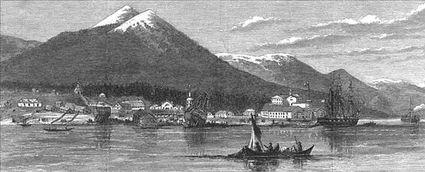Bad land deal triggered 1802 Tlingit attack
Aunt Phil's Trunk

University of Washington, Alaska and Western Canada Collection, AWC0322
The Tlingit people inhabited the land around Shee Atika, today called Sitka, for more than 10,000 years. In 1804, Russian-American Company manager Alexander Baranof renamed it New Archangel following the last major battle between Alaska Natives and the Europeans.
Russian fur traders wanted to build a fort called Mikhailovsk about six miles north of the present town of Sitka in 1799. They gave the Tlingits, who'd occupied that part of Southeast Alaska for more than 10,000 years, beads and other trading goods in exchange for a small piece of land.
The Native people at first thought the Russians might be good trading partners. But soon they realized they'd made a bad deal with Alexander Baranof, chief manager for the Russian-American Company. Submission to the Russians meant working for free and allegiance to the Czar.
During the next two years, the Natives of Shee Atika (Sitka) grew more sullen and hostile toward the Russian intruders. By 1802, they were ready to take back their land.
While Baranof was away in Kodiak that summer, a horde of warriors from the Kiks.ádi clan quietly crept out of the woods and climbed over the stockade walls.
The Russians attempted to barricade the main buildings, but the assailants broke down the doors and windows and poured into the settlement. A hunter, who'd been down at the river and missed the massacre, later gave his report:
"... I noticed at the fort a great multitude of Kolosh people, who had not only surrounded the barracks below, but were already climbing over the balcony and to the roof with guns and cannon; and standing upon a little knoll in front of the outhouses, was the Sitka toyon, or chief, Mikhail, giving orders to those who were around the barracks, and shouting to some people in canoes not far away, to make haste and assist in the fight."
The hunter witnessed the Natives slaughtering the Russian men and carrying the women and children away. He saw them empty out the buildings, set fire to the compound and retreat back into the woods.
The hunter spent eight days hiding, until he spotted an English ship in the bay. He told its commander, Capt. Barber, his story and led him to the destroyed fort. They buried the dead.
The captain then rounded up the Tlingit chiefs and threatened to hang them if they did not hand over all captives and possessions taken from the Russian post. He then took the survivors to Kodiak, where he demanded Baranof pay him 50,000 rubles in furs as ransom.
Baranof, learning that the captain's only expense had been in feeding and clothing his passengers, paid him 10,000 rubles for the release of three Russians, five Aleut men and 18 women and children.
In April 1804, Baranof returned to Sitka with four small ships, 300 canoes, and a crew of 121 Russians and 800 Aleuts. His initial assault was not successful, but the naval escorts bombarded the Tlingits and drove them into the forest after a couple days.
Following the decisive win, Baranof erected a stronger stockade and buildings and renamed the settlement New Archangel. And although this was the last major battle between Alaska Natives and Europeans, sporadic attacks were reported against the Russians as late as 1858.
This column features tidbits found among the writings of the late Alaska historian, Phyllis Downing Carlson. Her niece, Laurel Downing Bill, is turning many of Carlson's stories into a series of books titled "Aunt Phil's Trunk." Volumes 1-4 are available at bookstores and gift shops throughout Alaska, as well as online at http://www.auntphilstrunk.com.





